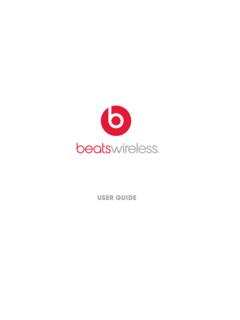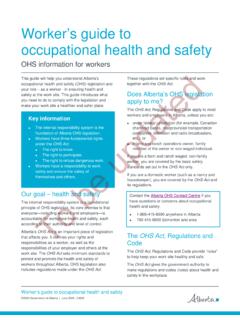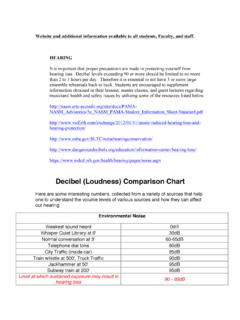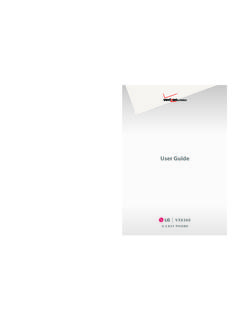Transcription of A Model Hearing Conservation Program
1 A Model Hearing Conservation ProgramDavid C. ByrneMining Hearing Loss Prevention WorkshopJune 21-22, 2005 Pittsburgh Research LaboratoryIf you have a Hearing loss, this is what you might hear when someone is talking to o i e i on e wel if you had normal Hearing , you would hear office is on the twelfth floorStandards and Guidelines MSHA Part 62 Occupational Noise Exposure NIOSH Practical Guide Preventing Occupational Hearing Loss NIOSH 1998 Criteria Document Occupational Noise Exposure A Model Hearing Conservation Program for Coal Miners (Penn State University) Hearing Conservation Program The purpose of a Hearing Conservation Program (HCP) is to prevent the occurrence or reduce the progression of noise-induced Hearing loss.
2 An MSHA-compliant HCP includes: Noise exposure monitoring Hearing protection Hearing testing Training RecordkeepingHearing Conservation Program A NIOSH-recommended Hearing Loss Prevention Program (HLPP) includes: Initial/annual audits of procedures Noise exposure monitoring Engineering/administrative noise controls Hearing testing Hearing protection Education and motivation of workers Recordkeeping Program evaluationHLPP Program Audit 1ststep before any changes are made or a new Program is implemented Business Plan Administrative issues; regulations Company policies Responsible individual(s) Individual roles (who/when/how measures noise levels, performs Hearing tests, orders Hearing protectors, performs training, etc.)
3 HLPP Program Audit Administrative issues should beexamined first Next, go through each element of Program Appendix B - NIOSH Practical Guide has a Program Evaluation Checklist Review audit annually easily identify shortcomings or problems Monitoring Noise Exposures This part of the Hearing Conservation Program is done with either a sound level meter (SLM) or a dosimeter. These SLM or dosimeter noise exposure level measurements determine if a miner s noise exposure levels are equal to or greater than 85 dB(A), called the Action Level.
4 All miners whose noise exposure equals or exceeds the Action Level are required to be enrolled in an Measuring Devices The noise dosimeter is worn by a miner as he goes about his daily work. The dosimeter takes many noise measurements and compiles them into a final reading. A SLM also measures the noise levels, but the noise levels are recorded and the exposures are calculated by a & Administrative Noise Controls 1stline of defense against loud noise Remove the hazard or remove the worker Goal: reduce the noise level so that the other elements of the HLPP are not necessary Technological vs.
5 Economic feasibility Buy Quiet policy for new equipmentMaintaining Noise Controls After noise controls have been established, they must be consciously implemented by miners and operators. Engineering controls mustbe maintained. Changes in equipment If equipment has aged, sounds differently, or is in need of maintenance, miners need to notify their Testing Hearing ability is measured for different tones in each ear The miner wears earphones and is placed in a test room (low background noise) Hearing thresholds are recorded and plotted on a graph called an audiogramAudiogram An audiogram is a graphic representation of a miner s Hearing levels for different pitched sounds for each ear.
6 Baseline Audiogram The 1sthearing test is called the baseline audiogram. Future audiograms are then compared with the baseline to determine if a miner s Hearing has gotten worse Done within 6 months of being enrolled in a HCP or within 12 months if a mobile testing service is usedBaseline Audiogram The miner should be in a quiet area for 14 hoursor wear Hearing protectors if he/she is working. This also means that loud noises at home should be avoided before the Hearing test. The Hearing Test There is no passingor failinga Hearing test.
7 Current test is compared to the baseline Hearing test --changesin a miner s Hearing can be easily detected. If changes are found, immediate action must be taken (so that it doesn t continue to get worse)Standard Threshold Shift A Standard Threshold Shift (STS) is a decrease in a miner s Hearing by an average of 10 dB compared to the baseline audiogram. Miners need to: start wearing Hearing protectors, or be re-trained about wearing protectors, or wear more effective Hearing protectors. Scheduling Hearing TestsAudiograms should be performed on the following (before assignment to a noise-hazardous area) [when TWA 85 dB(A)] out of a noise-hazardous of employmentScheduling Hearing TestsWhether an outside vendor or in-house person conducts the Hearing calibration (audiometer and booth)
8 Is technicians should be trained to CAOHC should be done under the supervision of an audiologist or physicianScheduling Hearing Tests Baseline tests -- 14 hours noise-free Annual tests -- midway through or at the end of the workshift Check for insufficient noise controls or inadequate use ofhearing protectors Immediately compare annual to baseline to identifychanges and give feedback (training opportunity) Hearing Protection Devices As part of the HCP, miners must be offered a choice of Hearing protection devices Procurement officers should not be able to over-ride the selection made by HLPP personnelTrainingTraining is done to explain.
9 (MSHA standard) The effects of noise on Hearing Purpose and value of wearing Hearing protectors Advantages and disadvantages of the Hearing protectors being offered Care, fitting, and use of Hearing protectors miners and operators tasks in maintaining noise controls Purpose and value of audiometric testingEducation & Motivation Those who understand the reasons for the HLPP are more likely to participate Managers/supervisors must attend training sessions (outline company policies and show commitment) Training must be tailoredto the audience and theirparticular needs SUPERVISOR INVOLVEMENTIS THE KEY TO SUCCESS!
10 Education & Motivation Speakers/presenters must be capable of getting the miners attention Peers are often very influential ( , if a senior miner already has a Hearing loss) Training is best done in small groups ( , miners that work together and have similar noise exposures) Training is also very effective at the time of the annual Hearing testRecordkeeping The mine operator is responsible for keeping the records of all Hearing tests. Hearing tests, noise surveys, trainingrecords, other supporting documents,etc. are often needed many years after they are collected.













